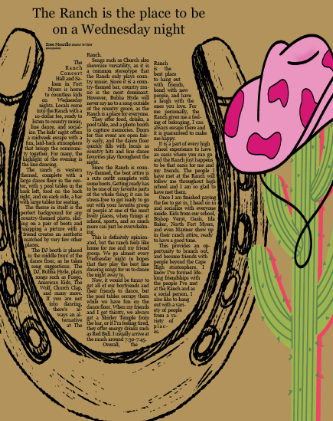The long fight for women’s rights in the United States
1776-1848:
From the beginning of US history, women have been fighting to have their rights recognized in the eye of the law. Equal rights groups are not a new subject to be discussed, as forefather’s wives and daughters have been recorded stating that laws that aren’t equal won’t be respected.
Future First Lady Abigail Adams, in a letter to her husband John Adams, told him to “remember the ladies and be more generous and favorable to them than your ancestors.” Written in 1776, this letter set the tone of female equality that would take over a hundred years to be amplified.
A movement is born. 75 years after First Lady Adams wrote to her husband pleading for change, the first woman’s rights convention took place in Seneca Falls, New York in 1848.
A congregation of hundreds of people demanded civil, social, political, and religious rights for women throughout the country. Met with backlash in the eye of the public, leaders Elizabth Cady Stanton and Lucretia Mott started the fire that would be fueled by citizens tired of not having their voices heard.
1848-1851:
A carefully crafted tower of dominoes begins to crumble. On May 29, 1851, the formerly enslaved abolitionist and women’s rights activist, Sojourner Truth delivered her “Ain’t I a Woman?” speech at the Women’s Rights Convention in Akron, Ohio. A New Yorker, Truth’s speech would go on to be distorted, adding to the fire of false beliefs that as a formerly enslaved woman, Truth must have had a southern accent.
1851-1865:
Things weren’t changing fast enough, and not enough of what was being fought for was being recognized. Early women’s rights activists wanted more than just suffrage. Voting was not the main goal; racism, econmic oppression, and sexual violence plagued women across the United States.
The Declaration of Sentiments, written by Cady Stanton, was modeled after the Declaration of Independence, and protested women’s inability to access higher education, as “nearly all the profitable employments” that employed women only received “but scanty remuneration.”
Most importantly, the Declaration protested coverture, which was the legal doctrine stating that a married woman’s possession, wages, body, and children to use how they wanted to.
Early activists saw these injustices as of higher importance and necessity compared to only suffrage. Marital coverture, racism, economic oppression, and sexual violence were of the top concerns in their visions towards gender equality.
1865:
1865 marked the end of the Civil War and the halt on women’s rights advocacy. Cady Stanton and Susan B. Anthony formed the American Equal Rights Association, petitioning Congress for “universal suffrage.” Composed of white and black people, the association was dedicated to their cause of equal rights.
1868:
Ratification of the 14th Amendment to the Constitution occurred in 1868, making all “persons born or naturalized in the United States” citizens of the United States and their home state, giving African-American men the right to vote and to be recognized as citizens.
Following the ratification of the 14th Amendment, the introduction of a federal women’s suffrage amendment by Senator S.C. Pomery of Kansas is rejected in Congress, marking the first attempt to amend the U.S. Constitution to allow female citizens in the United States to vote.
While in theory, the 14th Amendment would make it so African-American men could vote, this did not correspond to state laws in practice. Because of this, Congress passed the 15th Amendment to the Constitution in 1869, which stated, “The right of citizens of the United State to vote shall not be denied or abridged by the United States or by any State on account of race, color, or previous condition of servitude.”
1869:
1869 marks the division of the Women’s Suffrage Movement, as different views of how to receive suffrage force activists to separate, never working together for the rest of the 19th century.
Cady Stanton and Anthony founded the National Woman Suffrage Association (NWSA), a radical institution that worked to achieve voting through a Constitutional amendment and pushed for other women’s rights issues like marital coverture and economic oppression.
1869-1917:
Lucy Stone, Henry Blackwell, and Julia Ward Howe form the more conservative American Woman Suffrage Association (AWSA), which worked for equality by amending individual state constitutions.
Anthony casts her ballot for Ulysses S. Grant in the 1872 presidential election, and is arrested and brought to trial in Rochester, New York. Along with this, fifteen other women were arrested for illegally voting, along with Sojourner Truth turned away to vote at the ballet booth in Battle Creek, Michigan.
Six years later, A Women’s Suffrage Amendment was proposed to Congress and vetoed.
In 1916, Margaret Sanger opened the first birth control clinic in the United States; however, under the “Comstock Laws” her clinic in Brooklyn was deemed illegal and raided ten days later. After multiple legal threats, Sanger closed the clinic and would go on to found the American Birth Control League in 1921, the beginning of today’s Planned Parenthood.
1917-1918:
Less than a year after the opening of Sanger’s clinic, longtime activist with the NWSA, Jeannette Rankin, was sworn in as the first woman elected to Congress as a memory of the House of Representatives.
Rankin worked to expand voting rights for women, to ensure better working conditions for laborers, and to improve health care for women and infants. Best known for her votes to keep America out of the world wars, Rankin was a pathbreaker, “I may be the first woman member of Congress, but I won’t be the last.”
1920:
August 18th, 1920, the day that forever changed the course of voting rights in the United States. The ratification of the 19th Amendment to the US Constitution was completed, declaring that “the right of citizens of the United States to vote shall not be denied or abridged by the United States of by any State on account of sex.” Often referred to as “the Susan B. Anthony Amendment” because of her work on behalf of women’s suffrage, the 19th Amendment gave American women full voting rights.
1920-1943:
In theory, the ratification of the 19th Amendment would make it so all people, regardless of sex, would have the ability to vote. However, most Southern States did not allow African American women the right to vote through Jim Crow laws.
Poll taxes, literacy tests, grandfather clauses, and violence all kept African Americans, especially women, from voting. Two months after the 19th Amendment was ratified, prominent African American suffrage activist Mary Church Terrell wrote a letter to the National Association for the Advancement of Colored People (NAACP) filled with foreboding.
1943-1955:
“The colored women of the South will be shamefully treated, and will not be alowed [sic] to vote, I am sure. I hope the Republicans will do something toward enforcing the Fifteenth Amendment. We are so helpless without the right of citizenship in that section of the country where we need it most.”
Along with African Americans, other groups who were excluded from the vote included Asian American immigrants, who weren’t able to vote on the account of race, and were only able to vote starting in 1943.
1943-1955:
Indigenous people were also not allowed to vote, as they weren’t made US citizens until 1924, and still considered “wards of the state” in some states following the granting of citizenship. It wasn’t until the passage of the 1965 Voting Rights Act that all native people could vote in the US.
1955-1956:
Fast forward to the Civil Rights Movement, December 1st, 1955, Rosa Parks refused to give up her seat to a white man on a bus in Montgomery, Alabama. Parks was found guilty of violating segregation laws, given a suspended sentence, and fined as a result.
However, Black participation in the Montgomery Boycott was much larger than anticipated. The Montgomery Bus Boycott led to increased violence, yet that didn’t deter the boycotters or their leaders. This attention from the boycott gained recognition from the national and international press.
1956-1964:
On November 13th, 1956, the Supreme Court ruled that bus segregation was unconstitutional, and the boycott ended on December 20th, a day after the Court’s written order arrived in Montgomery. As a result, Parks became known as the “mother of the civil rights movement.”
Seven years later, President John F. Kennedy signed into law the Equal Pay Act, which prohibited sex-based wage discriminated between women and men performing the same job in the workplace environment. All forms of compensation were made to be covered. The Equal Pay Act made it so all wage aspects of the work environment were equal between workers of both sexes
1964:
.
In 1964, President Lyndon B. Johnson signed the Civil Rights Act into law, banning employment discrimination based on race, religion, national origin, or sex. Under Title VII, an employer can not discriminate with regard to any term, condition, or privilege of employment, and applies to both the private and public sectors that have at least 15 employees.
The Civil Rights Act ended segregation in all public places, and was originally proposed by President Kennedy, who stated that the United States “will not be fully free until all of its citizens are free.” On the grounds of race, religion, or national origin, segregation was banned in every single place of public accommodation, which included courthouses, parks, restaurants, hotels, and more, meaning that no longer could people of color be denied service simply based on their race.
1965-1966:
After Kennedy’s assassination in 1963, President Johnson immediately took up continuing the fight for civil rights.
“Let this session of Congress be known as the session which did more for civil rights than the last hundred sessions combined,” Johnson said during his first State of the Union address, taking action to fix the suffering that minority women had faced for decades.
1966-1981:
In 1966 Betty Friedan, helped to found the National Organization for Women (NOW), using, as the organization states, “grassroots activism to promote feminist ideals, lead societal change, eliminate discrimination, and achieve and protect the equal rights of all women and girls in all aspects of social, political, and economic life.” NOW is an “intersectional, multi-issue, multi-strategy organization that takes a holistic approach to women’s rights.”
Less than ten years after the founding of NOW, in the 7-2 Roe v. Wade decision, the Supreme Court declared that the Constitution protects a woman’s legal right to have an abortion. This ruling, however, was overturned by the Supreme Court in 2022.
1981-1983:
In July of 1981, Sandra Day O’Connor was sworn in by President Ronald Reagan as the first woman to serve on the Supreme Court and served for 24 years.
June of 1983 put the first American woman into space. Sally Ride, in an era of sexism, was one of the first six women to join NASA’s astronaut class of ‘78. One of NASA’s most well-known and respected astronauts, Ride changed the future of space travel for female astronauts.
1983-2013:
During this time, Clinton signed into effect the Violence Against Women Act, as a part of the Violent Crime Control and Law Enforcement Act. This act funded programs that help victims of domestic violence, rape, sexual assault, stalking, and other gender-ralted violence.
In 2007, US Representative Nancy Pelosi, a democratic candidate, became the first female speaker of the House.
Prior to 2013, women weren’t able to serve in combat positions in the US military. However, the Pentagon abolished this law, opening up positions for women serving in the military.
2013-2022:
In the 2016 presidential election, Hillary Clinton became the first woman to receive a presidential nomination from a major political party. Clinton, who ran against Donald Trump, won the popular vote but lost the electoral college.
On January 20th, 2021 Vice President Kamala Harris was sworn in as the first woman of color vice president in the United States. Harris was selected by President Joe Biden as his running mate in the recent election.
While the US has more that needs to be done in order for gender parity to be reached, the determination of movements will make sure that history will not repeat itself.
Your donation will support the student journalists of Cape Coral High School. Your contribution will allow us to purchase equipment and cover our annual website hosting costs.







